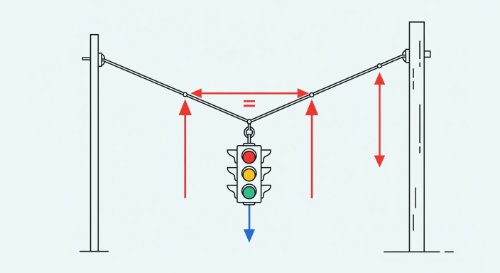[OAU, Ife] MEE 205: Engineering Mechanics I - Statics
23
Learning Track Courses
 Statics of Particles - Engineering Mechanics (Undergraduate Advanced)This course provides a complete guide to the statics of particles, a foundational topic in engineering mechanics. It covers the principles of force vectors, resultants, and components, first in two dimensions and then extending to three-dimensional space. The core of the course is the analysis of particles in equilibrium, establishing the conditions required for a particle to remain at rest under the influence of multiple concurrent forces.
Statics is the essential science behind structural and mechanical design. The principles covered are the basis for designing every stable structure, from bridges and skyscrapers to aircraft frames and engine components. A command of statics is non-negotiable for any engineer, as it provides the fundamental tools required to analyse forces and ensure the safety and integrity of physical systems.
By the end of this course, you will be able to resolve any force into its components and calculate the resultant of any system of concurrent forces in both 2D and 3D. You will also be able to draw a complete free-body diagram for any particle and apply the equations of equilibrium to solve for unknown forces, tensions, and reactions in a variety of engineering problems.
This course is for undergraduate students in any engineering discipline, including civil, mechanical, and aerospace. It is a core component of any engineering mechanics curriculum and assumes a prerequisite knowledge of introductory physics and vector mathematics. It is the essential foundation for subsequent courses in dynamics and the mechanics of materials.
Statics of Particles - Engineering Mechanics (Undergraduate Advanced)This course provides a complete guide to the statics of particles, a foundational topic in engineering mechanics. It covers the principles of force vectors, resultants, and components, first in two dimensions and then extending to three-dimensional space. The core of the course is the analysis of particles in equilibrium, establishing the conditions required for a particle to remain at rest under the influence of multiple concurrent forces.
Statics is the essential science behind structural and mechanical design. The principles covered are the basis for designing every stable structure, from bridges and skyscrapers to aircraft frames and engine components. A command of statics is non-negotiable for any engineer, as it provides the fundamental tools required to analyse forces and ensure the safety and integrity of physical systems.
By the end of this course, you will be able to resolve any force into its components and calculate the resultant of any system of concurrent forces in both 2D and 3D. You will also be able to draw a complete free-body diagram for any particle and apply the equations of equilibrium to solve for unknown forces, tensions, and reactions in a variety of engineering problems.
This course is for undergraduate students in any engineering discipline, including civil, mechanical, and aerospace. It is a core component of any engineering mechanics curriculum and assumes a prerequisite knowledge of introductory physics and vector mathematics. It is the essential foundation for subsequent courses in dynamics and the mechanics of materials.
This course provides a complete guide to the statics of particles, a foundational topic in engineering mechanics. It covers the principles of force vectors, resultants, and components, first in two dimensions and then extending to three-dimensional space. The core of the course is the analysis of particles in equilibrium, establishing the conditions required for a particle to remain at rest under the influence of multiple concurrent forces. Statics is the essential science behind structural and mechanical design. The principles covered are the basis for designing every stable structure, from bridges and skyscrapers to aircraft frames and engine components. A command of statics is non-negotiable for any engineer, as it provides the fundamental tools required to analyse forces and ensure the safety and integrity of physical systems. By the end of this course, you will be able to resolve any force into its components and calculate the resultant of any system of concurrent forces in both 2D and 3D. You will also be able to draw a complete free-body diagram for any particle and apply the equations of equilibrium to solve for unknown forces, tensions, and reactions in a variety of engineering problems. This course is for undergraduate students in any engineering discipline, including civil, mechanical, and aerospace. It is a core component of any engineering mechanics curriculum and assumes a prerequisite knowledge of introductory physics and vector mathematics. It is the essential foundation for subsequent courses in dynamics and the mechanics of materials.
 Systems of Forces on Rigid Bodies - Engineering Mechanics (Undergraduate Advanced)This course is a comprehensive guide to the effects of forces on rigid bodies, a critical topic in engineering mechanics. It moves beyond particles to analyse systems where the point of application of a force is crucial, introducing the concepts of moments and couples. The material covers the calculation of moments in two and three dimensions, the properties of couples, and the methods for reducing complex force systems into simpler, statically equivalent systems.
Understanding moments is fundamental to all structural and mechanical analysis. These principles are used to calculate the bending and twisting stresses in beams, shafts, and machine components, and to ensure the rotational stability of structures and vehicles. A command of this subject is non-negotiable for designing any object intended to withstand real-world loads without failing or rotating unintentionally.
By the end of this course, you will be able to calculate the moment of a force about any point or axis using both scalar and vector methods. You will also be able to determine the moment of a couple, and reduce any complex system of forces and couples acting on a rigid body to its simplest equivalent form, such as a single resultant force and couple moment at a specified point.
This course is for undergraduate students in any engineering discipline who have already completed a course on the statics of particles. It is the direct prerequisite for the study of the equilibrium of rigid bodies, and is a necessary foundation for advanced courses in dynamics, mechanics of materials, and structural analysis.
Systems of Forces on Rigid Bodies - Engineering Mechanics (Undergraduate Advanced)This course is a comprehensive guide to the effects of forces on rigid bodies, a critical topic in engineering mechanics. It moves beyond particles to analyse systems where the point of application of a force is crucial, introducing the concepts of moments and couples. The material covers the calculation of moments in two and three dimensions, the properties of couples, and the methods for reducing complex force systems into simpler, statically equivalent systems.
Understanding moments is fundamental to all structural and mechanical analysis. These principles are used to calculate the bending and twisting stresses in beams, shafts, and machine components, and to ensure the rotational stability of structures and vehicles. A command of this subject is non-negotiable for designing any object intended to withstand real-world loads without failing or rotating unintentionally.
By the end of this course, you will be able to calculate the moment of a force about any point or axis using both scalar and vector methods. You will also be able to determine the moment of a couple, and reduce any complex system of forces and couples acting on a rigid body to its simplest equivalent form, such as a single resultant force and couple moment at a specified point.
This course is for undergraduate students in any engineering discipline who have already completed a course on the statics of particles. It is the direct prerequisite for the study of the equilibrium of rigid bodies, and is a necessary foundation for advanced courses in dynamics, mechanics of materials, and structural analysis.
This course is a comprehensive guide to the effects of forces on rigid bodies, a critical topic in engineering mechanics. It moves beyond particles to analyse systems where the point of application of a force is crucial, introducing the concepts of moments and couples. The material covers the calculation of moments in two and three dimensions, the properties of couples, and the methods for reducing complex force systems into simpler, statically equivalent systems. Understanding moments is fundamental to all structural and mechanical analysis. These principles are used to calculate the bending and twisting stresses in beams, shafts, and machine components, and to ensure the rotational stability of structures and vehicles. A command of this subject is non-negotiable for designing any object intended to withstand real-world loads without failing or rotating unintentionally. By the end of this course, you will be able to calculate the moment of a force about any point or axis using both scalar and vector methods. You will also be able to determine the moment of a couple, and reduce any complex system of forces and couples acting on a rigid body to its simplest equivalent form, such as a single resultant force and couple moment at a specified point. This course is for undergraduate students in any engineering discipline who have already completed a course on the statics of particles. It is the direct prerequisite for the study of the equilibrium of rigid bodies, and is a necessary foundation for advanced courses in dynamics, mechanics of materials, and structural analysis.
 Equilibrium of Rigid Bodies - Engineering Mechanics (Undergraduate Advanced)Equilibrium is the foundation of all structural and mechanical analysis. This course provides a rigorous study of the equilibrium of rigid bodies in two and three dimensions. It covers reactions, equilibrium equations, constraints, and statical determinacy, supported by extensive worked examples.
Engineers, architects, and applied scientists constantly rely on equilibrium principles to design safe, efficient, and reliable systems. From bridges and buildings to machines and vehicles, every stable structure depends on correct modelling of supports, forces, and constraints. Mastery of equilibrium ensures accuracy in analysis and prevents costly or dangerous failures.
By completing this course, you will be able to draw free-body diagrams, apply equilibrium equations in 2D and 3D, and classify and analyse different support and constraint conditions. You will understand when a system is properly constrained, over-constrained, or indeterminate, and you will have practical experience solving a wide range of equilibrium problems.
This course is intended for undergraduate students in mechanical, civil, and structural engineering, but it is also useful to anyone studying applied mechanics at an advanced level. It provides both a theoretical foundation and practical problem-solving skills valuable to practising engineers, technical instructors, or anyone needing precise understanding of equilibrium in rigid body mechanics.
Equilibrium of Rigid Bodies - Engineering Mechanics (Undergraduate Advanced)Equilibrium is the foundation of all structural and mechanical analysis. This course provides a rigorous study of the equilibrium of rigid bodies in two and three dimensions. It covers reactions, equilibrium equations, constraints, and statical determinacy, supported by extensive worked examples.
Engineers, architects, and applied scientists constantly rely on equilibrium principles to design safe, efficient, and reliable systems. From bridges and buildings to machines and vehicles, every stable structure depends on correct modelling of supports, forces, and constraints. Mastery of equilibrium ensures accuracy in analysis and prevents costly or dangerous failures.
By completing this course, you will be able to draw free-body diagrams, apply equilibrium equations in 2D and 3D, and classify and analyse different support and constraint conditions. You will understand when a system is properly constrained, over-constrained, or indeterminate, and you will have practical experience solving a wide range of equilibrium problems.
This course is intended for undergraduate students in mechanical, civil, and structural engineering, but it is also useful to anyone studying applied mechanics at an advanced level. It provides both a theoretical foundation and practical problem-solving skills valuable to practising engineers, technical instructors, or anyone needing precise understanding of equilibrium in rigid body mechanics.
Equilibrium is the foundation of all structural and mechanical analysis. This course provides a rigorous study of the equilibrium of rigid bodies in two and three dimensions. It covers reactions, equilibrium equations, constraints, and statical determinacy, supported by extensive worked examples. Engineers, architects, and applied scientists constantly rely on equilibrium principles to design safe, efficient, and reliable systems. From bridges and buildings to machines and vehicles, every stable structure depends on correct modelling of supports, forces, and constraints. Mastery of equilibrium ensures accuracy in analysis and prevents costly or dangerous failures. By completing this course, you will be able to draw free-body diagrams, apply equilibrium equations in 2D and 3D, and classify and analyse different support and constraint conditions. You will understand when a system is properly constrained, over-constrained, or indeterminate, and you will have practical experience solving a wide range of equilibrium problems. This course is intended for undergraduate students in mechanical, civil, and structural engineering, but it is also useful to anyone studying applied mechanics at an advanced level. It provides both a theoretical foundation and practical problem-solving skills valuable to practising engineers, technical instructors, or anyone needing precise understanding of equilibrium in rigid body mechanics.